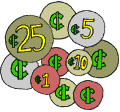
Lesson Three

Objective: After a lecture and discussion on comparing amounts of money, students learn how to compare amounts of money and choose the greater amount between given price values, with 80% accuracy.
Vocabulary: bill, coin, equivalent set, penny, nickel, dime, quarter, half dollar (penny = $0.01 or one cent; nickel = $0.05 or five cents; dime = $0.10 or ten cents; quarter = $0.25 or twenty-five cents; half dollar = $0.50 or fifty cents)
Materials:
* Manipulatives (play money)
* Worksheet
* Internet
Activities:
1. Review vocabulary and the value of each coin.
2. On the board the teacher draws various pictures in five different columns. Different price values will be assigned underneath each picture.
3. The teacher then distributes play money to the students and she tells them to come up with a total of five dollars.
4. After the students have done this, the teacher says the following "Row one,
you will each look at the pictures and price values in column A and you will
determine what things you would be able to buy from this column without
exceeding five dollars."
The teacher then tells row two to look at
column B, row three to look at column C, row four to look at column D, and row
five to look at column E. All rows will be instructed to do the same as row one,
which is to look at the pictures and price values in their corresponding column
and determine what things they would be able to buy without exceeding five
dollars.
5. The teacher adds up the price values of the things that the students say that they would buy up on the board in order to verify that the total does not exceed five dollars. The teacher also compares different amounts of money added and asks students to choose which is the greater amount between given price values.
6. After having introduced the concept of comparing amounts of money, the teacher tells the students to complete a worksheet. Students will be told that they could use their play money to help them add up different price values as they work. Meanwhile, the teacher walks around answering any questions that the students might have.
Web Activities:
1. Students make up their own riddles about money.
2. Students go online and play a flashcard game on money.
3. Students printout a wordsearch on money.
Enrichment Activity: worksheet (optional)
Evaluation: Worksheet (Students will complete the worksheet with 80% accuracy)
Home Learning: Students create 5 problems comparing amounts of money and complete a worksheet.